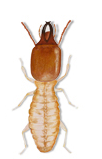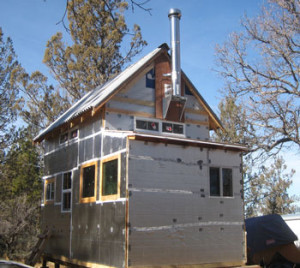And You Thought Termites Only Damaged Wood
By Chris Williams on January 13, 2015.
We’ve always known that termites will chew through various materials in their search for wood. They’ve been known to tunnel through books, plasterboard, paper products, carpeting, clothing, and insulation. If the material is made of cellulose like paper, termites can actually ingest it just like wood. But if it’s plastic or some other non-cellulose material, subterranean termites will tunnel into, and through, it on their way to somewhere else.
Foam insulation (boards, blocks, and loose-fill) often suffers when termites are on the move. The material is soft and easy to penetrate. Termites appreciate the fact that insulation retains moisture, maintains temperature, and protects them from enemies. Termites burrowing in insulation can cause water damage from the excess moisture and soil that termites bring into a structure.
Termite Damage to Insulation Affects Energy Costs
 Termite damage has been most commonly thought of in terms of weakening the wood in structures, making infested areas prone to collapse. But until recently, we did not appreciate the problems caused when termites change the thermal properties of a structure by damaging insulation.
Termite damage has been most commonly thought of in terms of weakening the wood in structures, making infested areas prone to collapse. But until recently, we did not appreciate the problems caused when termites change the thermal properties of a structure by damaging insulation.
A few years ago, entomologists at the University of Florida decided to see what problems might result when termites encounter building insulation. They gave subterranean termites their choice of 2X4 wooden boards, 5-ply plywood, or foam board insulation. The insulation suffered more damage than either of the wood boards, with 12% of the foam being removed during the 8 week study. This resulted in a 27% loss in insulation values.
Foam Board Insulation Used Below Grade
In response to today’s energy-saving measures, certain building methods use rigid foam board insulation that extends below grade, or foam insulation forms between which concrete is formed for foundation walls. These construction methods evolved with little thought for future termite problems. Foam board insulation at or below grade provides the structure-to-soil contact that allows termites to move into a home, either by tunneling through the foam, or by simply following along a seam.
Foam board insulation also makes inspection and treatment difficult. Unfortunately, even if a termite problem is successfully resolved, a homeowner will not be able to correct the thermal damage or restore the insulation without significant expense. There is no way to treat foam board so it usually must be partially removed. Any energy savings from the foam insulation may be overcome by the costs associated with a termite infestation.
Manufacturers are working on ways to protect foam board insulation from termites, such as specialty coverings or impregnating the board with pesticide, while others are working to change building codes so that foam board is not installed below grade.
Photo credit: ryochiji / Foter / CC BY
Photo credit: tracywoolery / Foter / CC BY-ND
Stay up-to-date with Colonial Pest’s email newsletter!
